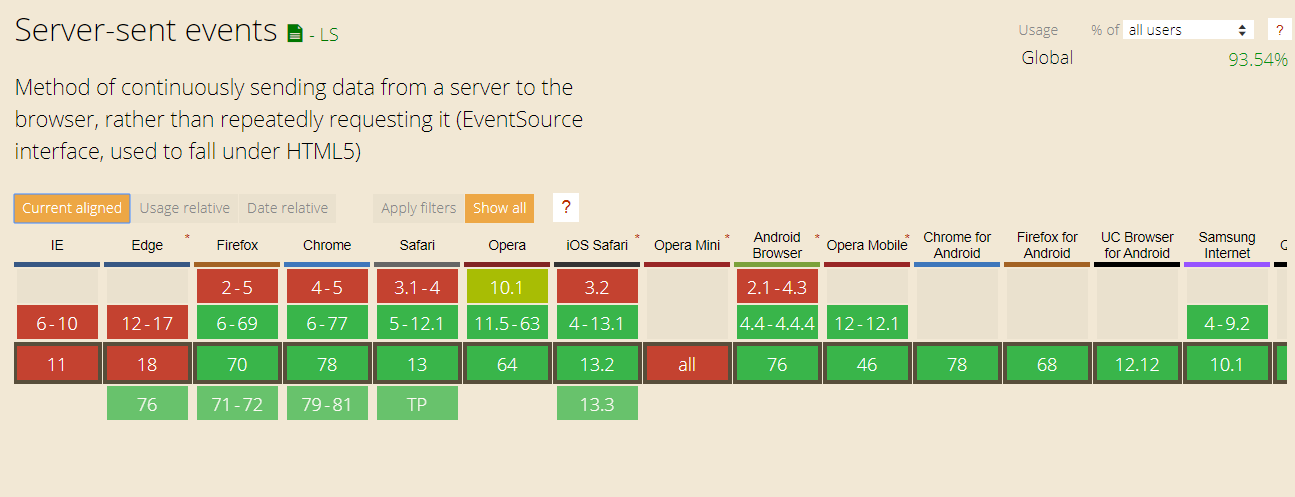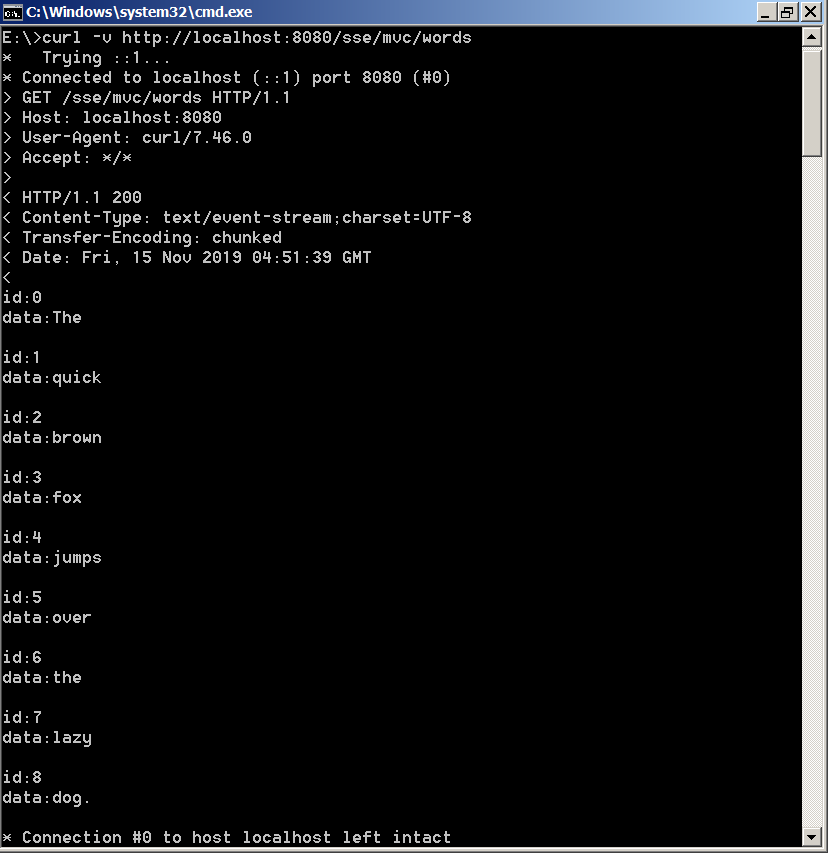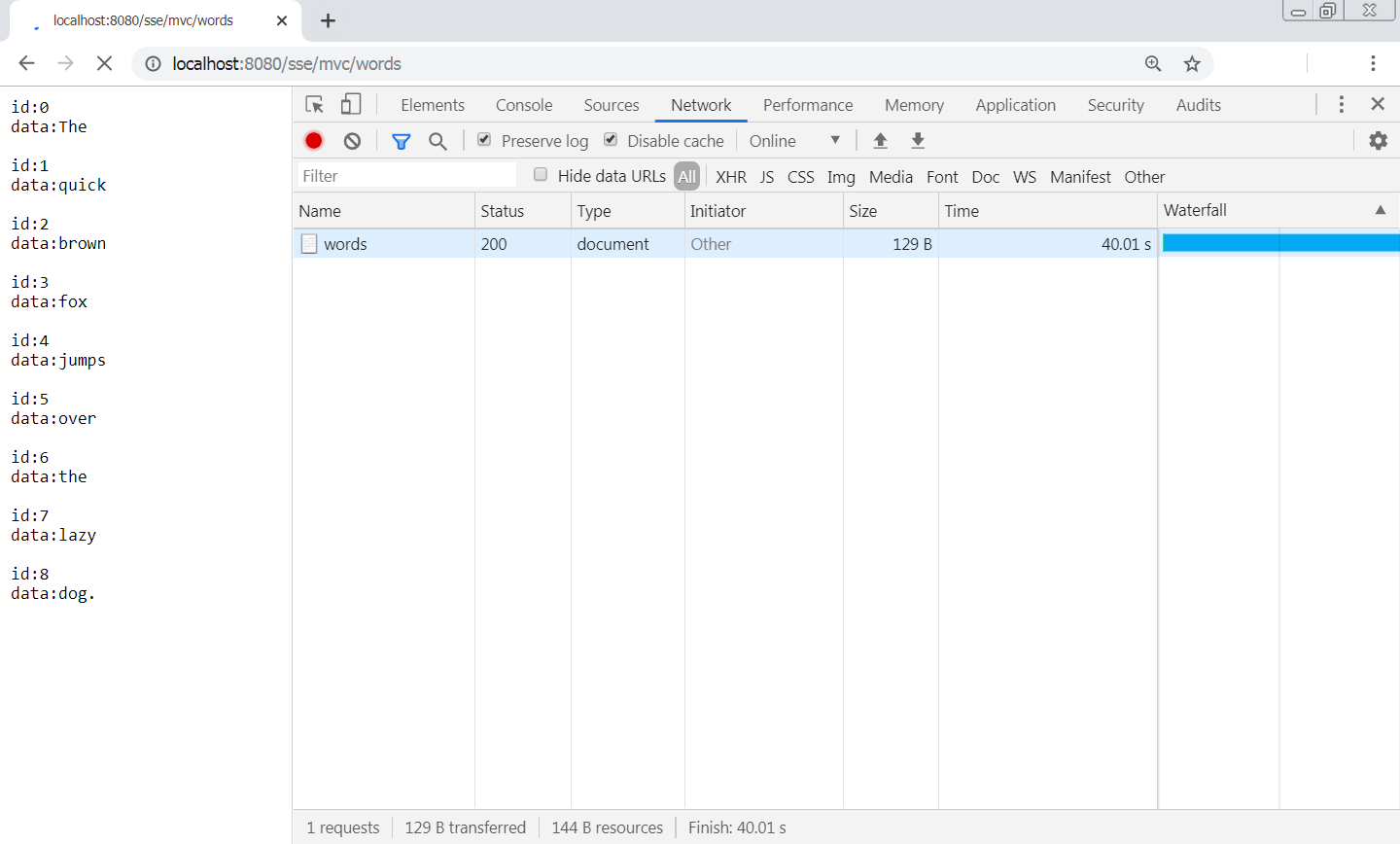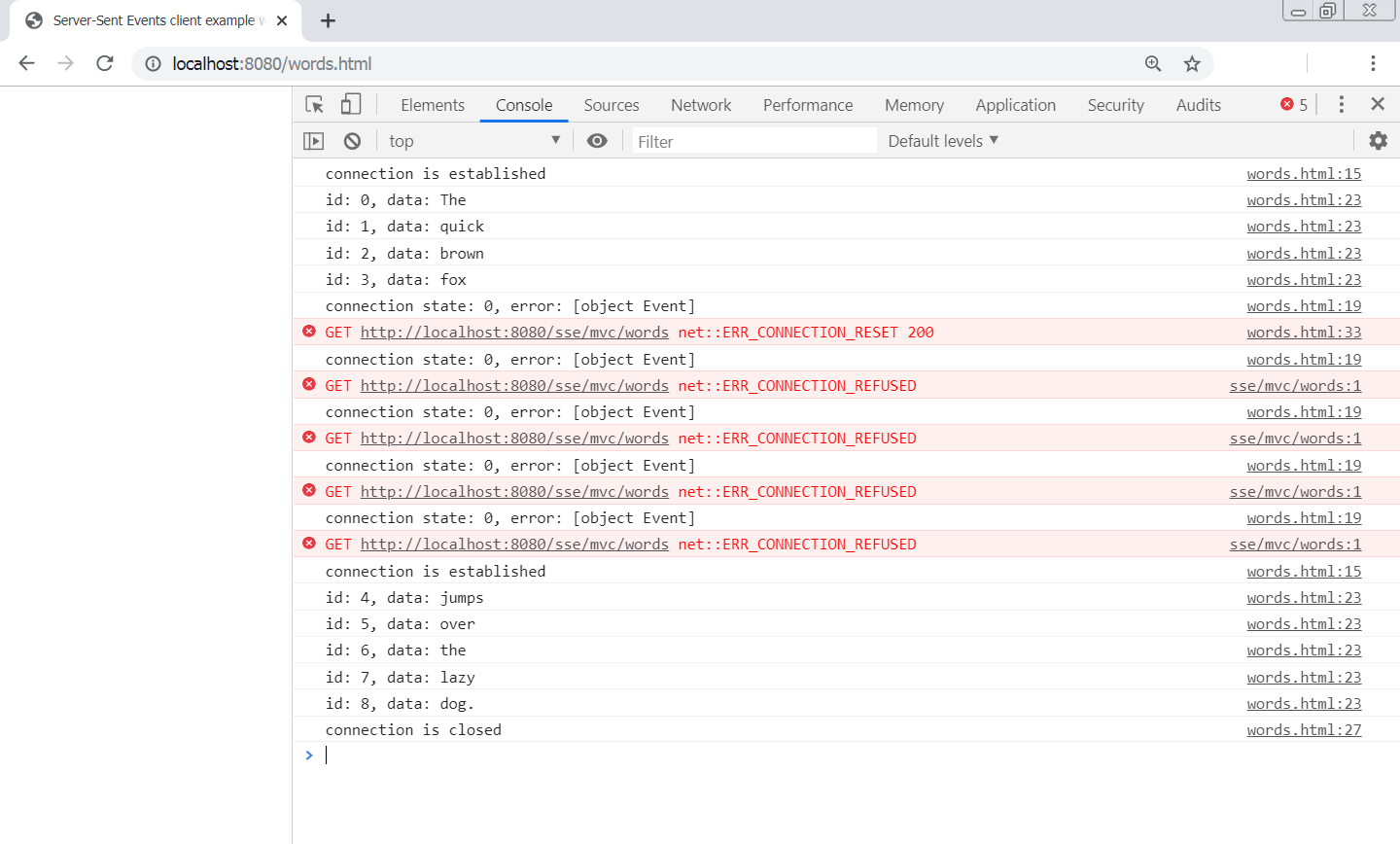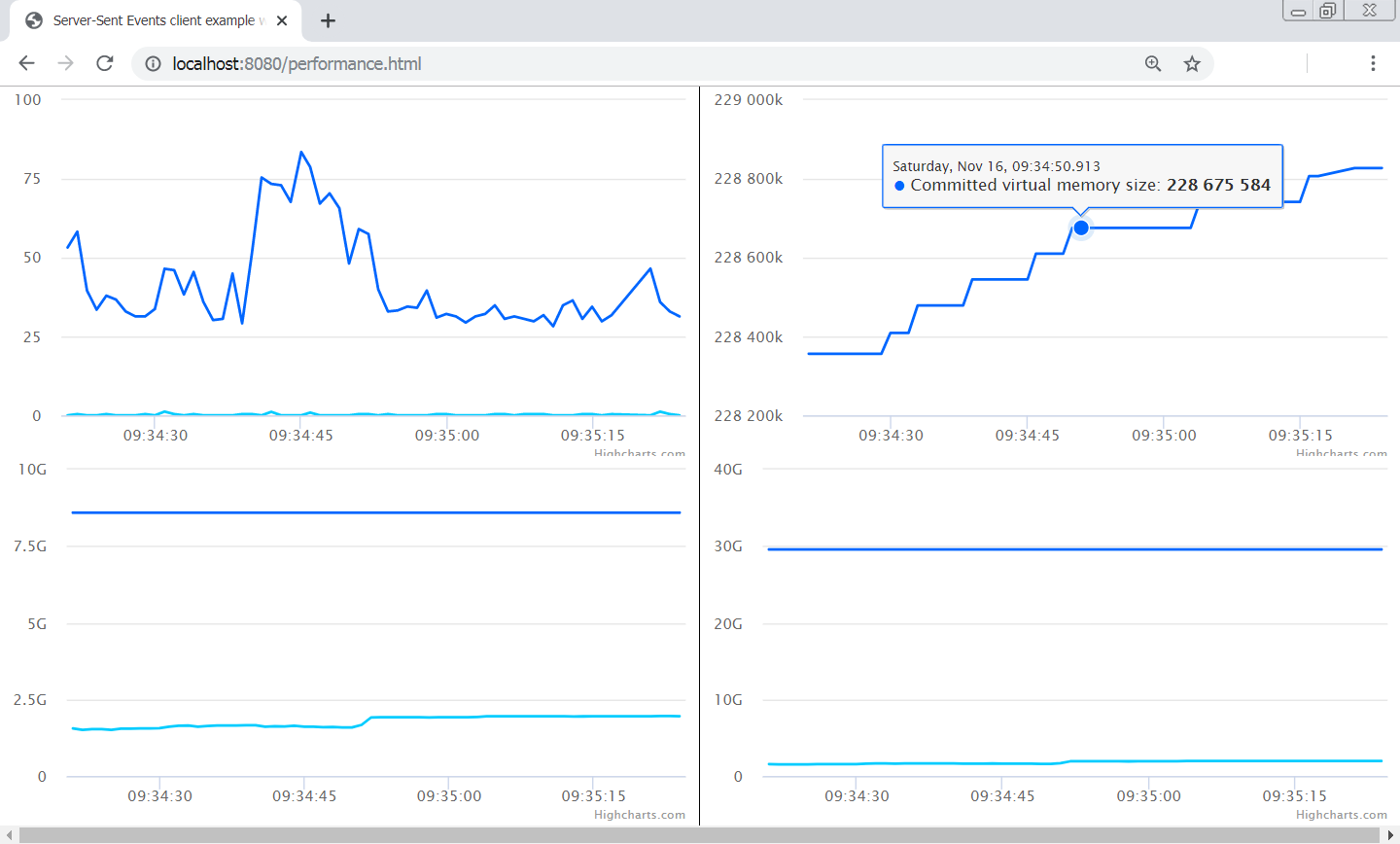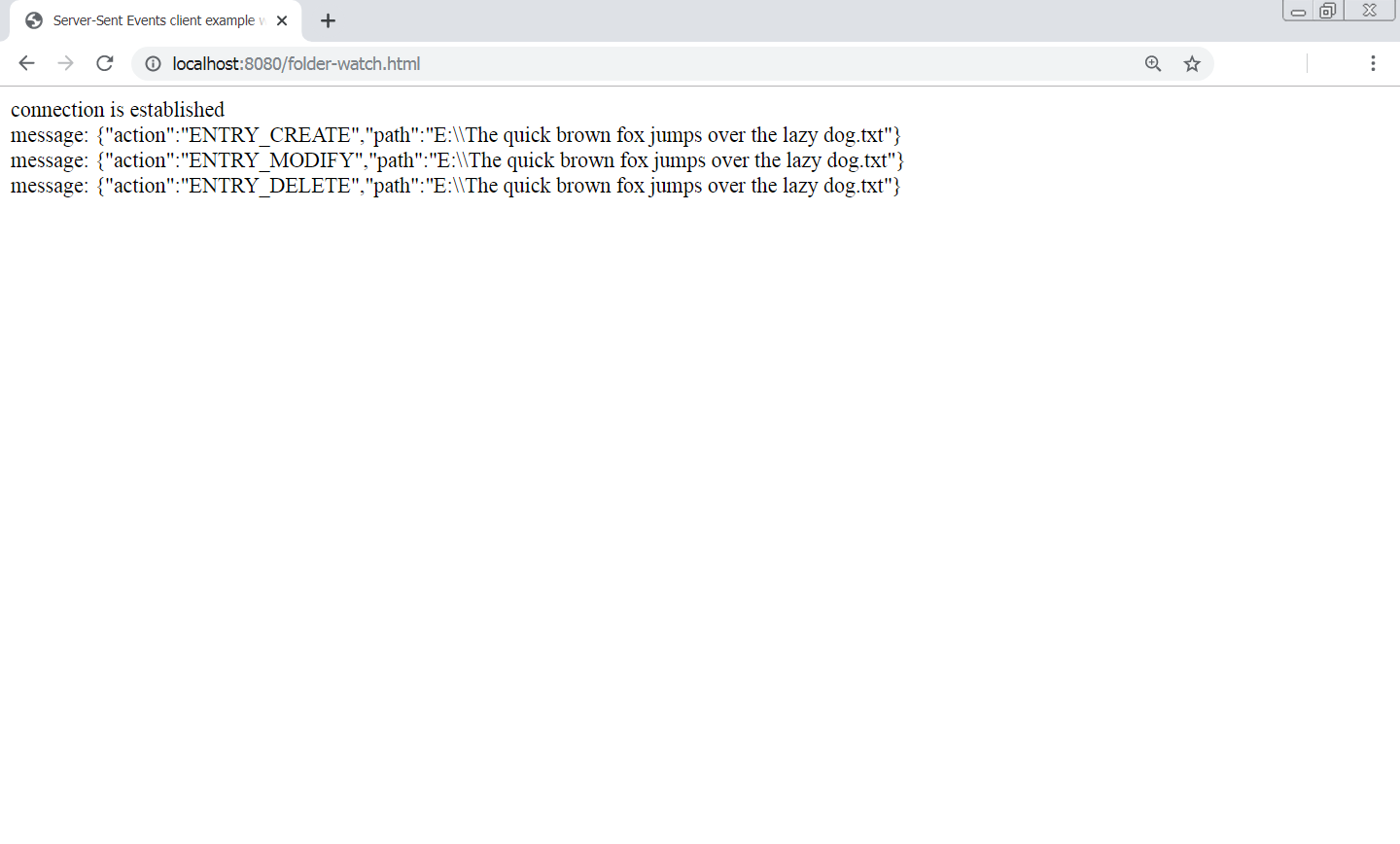aliakh / Demo Spring Sse
Programming Languages
Projects that are alternatives of or similar to Demo Spring Sse
Server-Sent Events (SSE) in Spring 5 with Web MVC and Web Flux
Introduction
There are no simple, general-purpose methods to implement asynchronous server-to-client communication in web applications with acceptable performance.
HTTP is a request-response protocol in the client-server computing model. To start an exchange, a client submits a request to a server. To finish the exchange, the server returns a response to the client. The server can send a response to only one client - the one that made the request. In the HTTP protocol, a client is the initiator of messages exchange.
There are cases when a server should be the initiator of exchange. One of the methods to implement this is to allow the server to push messages to clients in the publish/subscribe computing model. To start an exchange, a client subscribes to messages from the server. During the exchange, the server sends messages (as soon as they become available) to many subscribed clients. To finish the exchange, the client cancels the subscription.
Server-Sent Events (SSE) is a simple technology to implement asynchronous server-to-client communication for specific web applications.
Overview
There are several technologies that allow a client to receive messages about asynchronous updates from a server. They can be divided into two categories: client pull and server push.
Client pull
In client pull technologies, a client periodically requests a server for updates. The server can respond with updates or with a special response that it has not yet been updated. There are two types of client pull: short polling and long polling.
Short polling
A client periodically sends requests to a server. If the server has updates, it sends a response to the client and closes the connection. If the server has no updates, it sends a special response to the client and also closes the connection.
Long polling
A client sends a request to a server. If the server has updates, it sends a response to the client and closes the connection. If the server has no updates, it holds the connection until updates become available. When updates are available, the server sends a response to the client and closes the connection. If updates are not available for some timeout, the server sends a special response to the client and also closes the connection.
Server push
In server push technologies, a server proactively sends messages to clients immediately after they are available. Among others, there are two types of server push: Server-Sent Events and WebSocket.
Server-Sent Events
Server-Sent Events is a technology to send text messages only from a server to clients in browser-based web applications. Server-Sent Events is based on persistent connections in the HTTP protocol. Server-Sent Events has the network protocol and the EventSource client interface standardized by W3C as part of HTML5 standards suite.
WebSocket
WebSocket is a technology to implement simultaneous, bi-directional, real-time communication in web applications. WebSocket is based on a protocol other than HTTP, so it can require additional setup of network infrastructure (proxy servers, NATs, firewalls, etc). However, WebSocket can provide performance that is difficult to achieve with HTTP-based technologies.
SSE network protocol
To subscribe to server events, a client should make a GET request with the headers:
-
Accept: text/event-streamindicates media type of events required by the standard -
Cache-Control: no-cachedisables any events caching -
Connection: keep-aliveindicates that a persistent connection is being used
GET /sse HTTP/1.1
Accept: text/event-stream
Cache-Control: no-cache
Connection: keep-alive
A server should confirm the subscription with a response with the headers:
-
Content-Type: text/event-stream;charset=UTF-8indicates media type and encoding of events required by the standard -
Transfer-Encoding: chunkedindicates that the server streams dynamically generated content and therefore the content size is not known in advance
HTTP/1.1 200
Content-Type: text/event-stream;charset=UTF-8
Transfer-Encoding: chunked
After subscribing, the server sends messages as soon as they become available. Events are text messages in UTF-8 encoding. Events are separated one from another by two newline characters \n\n. Each event consists of one or many name: value fields, separated by a single newline character \n.
In the data field, the server can send event data.
data: The first event.
data: The second event.
The server can split the data field into several lines by a single newline character \n.
data: The third
data: event.
In the id field the server can send a unique event identifier. If a connection is broken, the client should automatically reconnect and send the last received event id with the header Last-Event-ID.
id: 1
data: The first event.
id: 2
data: The second event.
In the event field the server can send event type. The server can send events of different types, as well as without any type, in the same subscription.
event: type1
data: An event of type1.
event: type2
data: An event of type2.
data: An event without any type.
In the retry field the server can send timeout (in milliseconds), after which the client should automatically reconnect when a connection is broken. If this field is not specified, by the standard it should be 3000 milliseconds.
retry: 1000
If a line begins with a colon character :, it should be ignored by the client. This can be used to send comments from the server or to prevent some proxy servers from closing the connection by timeout.
: ping
SSE client: EventSource interface
To open a connection, it should be created an EventSource object.
var eventSource = new EventSource('/sse);
Despite Server-Sent Events is designed to send events from server to client the it’s possible to use GET query parameters to pass data from client to server.
var eventSource = new EventSource('/sse?event=type1);
...
eventSource.close();
eventSource = new EventSource('/sse?event=type1&event=type2);
...
To close the connection, it should be called method close().
eventSource.close();
There is the readyState attribute that represents the state of the connection:
-
EventSource.CONNECTING = 0- the connection has not yet been established, or it was closed and the client is reconnecting -
EventSource.OPEN = 1- the client has an open connection and is handling events as it receives them -
EventSource.CLOSED = 2- the connection is not open, and the client is not trying to reconnect either there was a fatal error or theclose()method was called
To handle an establishment of a connection, it should be subscribed to the onopen event handler.
eventSource.onopen = function () {
console.log('connection is established');
};
To handle some changes in the connection state or fatal errors, it should be subscribed to the onerrror event handler.
eventSource.onerror = function (event) {
console.log('connection state: ' + eventSource.readyState + ', error: ' + event);
};
To handle receiving events without the event field, it should be subscribed to the onmessage event handler.
eventSource.onmessage = function (event) {
console.log('id: ' + event.lastEventId + ', data: ' + event.data);
};
To handle receiving events with the event field, it should be subscribed to an event handler for such an event.
eventSource.addEventListener('type1', function (event) {
console.log('id: ' + event.lastEventId + ', data: ' + event.data);
}, false);
EventSource client interface is implemented in most modern browsers.
SSE Java server: Spring Web MVC
Introduction
Spring Web MVC framework 5.2.0 is based on Servlet 3.1 API and uses thread pools to implement asynchronous Java web applications. Such applications can be run on Servlet 3.1+ containers such as Tomcat 8.5 and Jetty 9.3.
Overview
To implement sending events with Spring Web MVC framework:
- create a controller class and mark it with the
@RestControllerannotation - create a method to create a client connection, that returns a SseEmitter, handles
GETrequests and producestext/event-stream- create a new
SseEmitter, to save it and to return it from the method
- create a new
- send events asynchronously, in another thread, get the saved
SseEmitterand call aSseEmitter.sendmethod as many times as necessary- to finish sending events, call the SseEmitter.complete() method
- to finish sending events exceptionally, call the SseEmitter.completeWithError() method
A simplified controller source:
@RestController
public class SseWebMvcController
private SseEmitter emitter;
@GetMapping(path="/sse", produces=MediaType.TEXT_EVENT_STREAM_VALUE)
SseEmitter createConnection() {
emitter = new SseEmitter();
return emitter;
}
// in another thread
void sendEvents() {
try {
emitter.send("Alpha");
emitter.send("Omega");
emitter.complete();
} catch(Exception e) {
emitter.completeWithError(e);
}
}
}
To send events with only the data field, it should be used the SseEmitter.send(Object object) method. To send events with the fields data, id, event, retry and comments, it should be used the SseEmitter.send(SseEmitter.SseEventBuilder builder) method.
In the examples below, to send the same events to many clients, the SseEmitters class was implemented. To create a client connection, there is the add(SseEmitter emitter) method that saves a SseEmitter in a thread-safe container. To send events asynchronously, there is the send(Object obj) method that sends the same event to all connected clients.
A simplified class source:
class SseEmitters {
private final List<SseEmitter> emitters = new CopyOnWriteArrayList<>();
SseEmitter add(SseEmitter emitter) {
this.emitters.add(emitter);
emitter.onCompletion(() -> {
this.emitters.remove(emitter);
});
emitter.onTimeout(() -> {
emitter.complete();
this.emitters.remove(emitter);
});
return emitter;
}
void send(Object obj) {
List<SseEmitter> failedEmitters = new ArrayList<>();
this.emitters.forEach(emitter -> {
try {
emitter.send(obj);
} catch (Exception e) {
emitter.completeWithError(e);
failedEmitters.add(emitter);
}
});
this.emitters.removeAll(failedEmitters);
}
}
Handling short-lasting periodic events stream
In this example, a server sends a short-lasting periodic events stream - a finite stream of words (The quick brown fox jumps over the lazy dog pangram) every second, until the words are finished.
To implement this, the mentioned SseEmitters class was used. To send events asynchronously and periodically, a cached thread pool has been created. Because the events stream is short-lasting, each client connection submits a separate task to the thread pool, right inside the controller method.
A simplified controller source:
@Controller
@RequestMapping("/sse/mvc")
public class WordsController {
private static final String[] WORDS = "The quick brown fox jumps over the lazy dog.".split(" ");
private final ExecutorService cachedThreadPool = Executors.newCachedThreadPool();
@GetMapping(path = "/words", produces = MediaType.TEXT_EVENT_STREAM_VALUE)
SseEmitter getWords() {
SseEmitter emitter = new SseEmitter();
cachedThreadPool.execute(() -> {
try {
for (int i = 0; i < WORDS.length; i++) {
emitter.send(WORDS[i]);
TimeUnit.SECONDS.sleep(1);
}
emitter.complete();
} catch (Exception e) {
emitter.completeWithError(e);
}
});
return emitter;
}
}
An events client example with curl command-line tool.
curl -v http://localhost:8080/sse/mvc/words
An events client example with SSE URL in a browser.
http://localhost:8080/sse/mvc/words
An events client source with EventSource JavaScript client.
<!DOCTYPE html>
<html lang="en">
<head>
<meta charset="UTF-8">
<title>Server-Sent Events client example with EventSource</title>
</head>
<body>
<script>
if (window.EventSource == null) {
alert('The browser does not support Server-Sent Events');
} else {
var eventSource = new EventSource('/sse/mvc/words');
eventSource.onopen = function () {
console.log('connection is established');
};
eventSource.onerror = function (error) {
console.log('connection state: ' + eventSource.readyState + ', error: ' + event);
};
eventSource.onmessage = function (event) {
console.log('id: ' + event.lastEventId + ', data: ' + event.data);
if (event.data.endsWith('.')) {
eventSource.close();
console.log('connection is closed');
}
};
}
</script>
</body>
</html>
An events client example with EventSource JavaScript client in a browser. There is used automatic reconnect on the client-side and the implemented reconnect on the server-side.
Handling long-lasting periodic events
In this example, a server sends long-lasting periodic events stream - a potentially infinite stream of server performance information every second:
- committed virtual memory size
- total swap space size
- free swap space size
- total physical memory size
- free physical memory size
- system CPU load
- process CPU load
To implement this the PerformanceService class was implemented which uses the OperatingSystemMXBean class to read performance information from an operations system. Also was used the mentioned SseEmitters class. To send events asynchronously and periodically, a scheduled thread pool has been created. Because the events stream is long-lasting, a single task is submitted to the thread pool to send events to all clients simultaneously.
A simplified controller example:
@RestController
@RequestMapping("/sse/mvc")
public class PerformanceController {
private final PerformanceService performanceService;
PerformanceController(PerformanceService performanceService) {
this.performanceService = performanceService;
}
private final AtomicInteger id = new AtomicInteger();
private final ScheduledExecutorService scheduledThreadPool = Executors.newScheduledThreadPool(1);
private final SseEmitters emitters = new SseEmitters();
@PostConstruct
void init() {
scheduledThreadPool.scheduleAtFixedRate(() -> {
emitters.send(performanceService.getPerformance());
}, 0, 1, TimeUnit.SECONDS);
}
@GetMapping(path = "/performance", produces = MediaType.TEXT_EVENT_STREAM_VALUE)
SseEmitter getPerformance() {
return emitters.add();
}
}
An events client example with Highcharts JavaScript library to draw charts of server performance.
Handling aperiodic events
In this example, a server sends aperiodic events stream about changes of files (create, modify, delete) in a folder being watched. As the folder is used the current user’s home folder available by the System.getProperty("user.home") property.
To implement this the FolderWatchService class was implemented which uses Java NIO files watch features. Also was used the mentioned SseEmitters class. To send events asynchronously and aperiodically, the FolderWatchService class produces Spring applications events, that are consumed by the controller (by implementing a listener method).
A simplified server example:
@RestController
@RequestMapping("/sse/mvc")
public class FolderWatchController implements ApplicationListener<FolderChangeEvent> {
private final FolderWatchService folderWatchService;
FolderWatchController(FolderWatchService folderWatchService) {
this.folderWatchService = folderWatchService;
}
private final SseEmitters emitters = new SseEmitters();
@PostConstruct
void init() {
folderWatchService.start(System.getProperty("user.home"));
}
@GetMapping(path = "/folder-watch", produces = MediaType.TEXT_EVENT_STREAM_VALUE)
SseEmitter getFolderWatch() {
return emitters.add(new SseEmitter());
}
@Override
public void onApplicationEvent(FolderChangeEvent event) {
emitters.send(event.getEvent());
}
}
An events client example using EventSource JavaScript client.
SSE Java server: Spring Web Flux
Introduction
Spring Web Flux framework 5.2.0 is based on Reactive Streams API and uses the event-loop computing model to implement asynchronous Java web applications. Such applications can be run on non-blocking web servers such as Netty 4.1 and Undertow 1.4 and on Servlet 3.1+ containers such as Tomcat 8.5 and Jetty 9.3.
Overview
To implement sending events with Spring Web Flux framework:
- create a controller class and mark it with the
@RestControllerannotation - create a method to create a client connection and to send events, that returns a Flux, handles
GETrequests and producestext/event-stream- create a new
Fluxand return it from the method
- create a new
A simplified controller source:
@RestController
public class ExampleController
@GetMapping(path="/sse", produces=MediaType.TEXT_EVENT_STREAM_VALUE)
public Flux<String> createConnectionAndSendEvents() {
return Flux.just("Alpha", "Omega");
}
}
To send events with only the data field, it should be used the Flux<T> type. To send events with the fields data, id, event, retry and comments, it should be used the Flux<ServerSentEvent<T>> type.
Handling short-lasting periodic events stream
In this example, a server sends a short-lasting periodic events stream - a finite stream of words (The quick brown fox jumps over the lazy dog pangram) every second, until the words are finished.
To implement this:
- create a
Fluxof the wordsFlux.just(WORDS)of typeFlux<String> - create a
Fluxthat emits incrementinglongvalues every secondFlux.interval(Duration.ofSeconds(1))of typeFlux<Long> - combine them together by
zipmethod to typeFlux<Tuple2<String,Long>> - extract the first element of the tuple by
map(Tuple2::getT1)of typeFlux<String>
A simplified controller source:
@RestController
@RequestMapping("/sse/flux")
public class WordsController {
private static final String[] WORDS = "The quick brown fox jumps over the lazy dog.".split(" ");
@GetMapping(path = "/words", produces = MediaType.TEXT_EVENT_STREAM_VALUE)
Flux<String> getWords() {
return Flux
.zip(Flux.just(WORDS), Flux.interval(Duration.ofSeconds(1)))
.map(Tuple2::getT1);
}
}
The event clients for this example are identical to those used in the Web MVC example.
Handling long-lasting periodic events
In this example, a server sends long-lasting periodic events stream - a potentially infinite stream of server performance information every second.
To implement this:
- create a
Fluxthat emits incrementinglongvalues every secondFlux.interval(Duration.ofSeconds(1))of typeFlux<Long> - convert it by
map(sequence -> performanceService.getPerformance())method to typeFlux<Performance>
A simplified controller example:
@RestController
@RequestMapping("/sse/flux")
public class PerformanceController {
private final PerformanceService performanceService;
PerformanceController(PerformanceService performanceService) {
this.performanceService = performanceService;
}
@GetMapping(path = "/performance", produces = MediaType.TEXT_EVENT_STREAM_VALUE)
Flux<Performance> getPerformance() {
return Flux
.interval(Duration.ofSeconds(1))
.map(sequence -> performanceService.getPerformance());
}
}
The event client for this example is identical to that used in the Web MVC example.
Handling aperiodic events
In this example, a server sends aperiodic events stream about changes of files (create, modify, delete) in a folder being watched. As the folder is used the current user’s home folder available by the System.getProperty("user.home") property.
To implement this the FolderWatchService class was implemented which uses Java NIO files watch features. To send events asynchronously and aperiodically, the FolderWatchService class produces Spring applications events, that are consumed by the controller (by implementing a listener method). The controller listener method sends events to a SubscribableChannel, that is subscribed in a controller method to produce Flux of events.
A simplified controller example:
@RestController
@RequestMapping("/sse/flux")
public class FolderWatchController implements ApplicationListener<FolderChangeEvent> {
private final FolderWatchService folderWatchService;
FolderWatchController(FolderWatchService folderWatchService) {
this.folderWatchService = folderWatchService;
}
private final SubscribableChannel subscribableChannel = MessageChannels.publishSubscribe().get();
@PostConstruct
void init() {
folderWatchService.start(System.getProperty("user.home"));
}
@GetMapping(path = "/folder-watch", produces = MediaType.TEXT_EVENT_STREAM_VALUE)
Flux<FolderChangeEvent.Event> getFolderWatch() {
return Flux.create(sink -> {
MessageHandler handler = message -> sink.next(FolderChangeEvent.class.cast(message.getPayload()).getEvent());
sink.onCancel(() -> subscribableChannel.unsubscribe(handler));
subscribableChannel.subscribe(handler);
}, FluxSink.OverflowStrategy.LATEST);
}
@Override
public void onApplicationEvent(FolderChangeEvent event) {
subscribableChannel.send(new GenericMessage<>(event));
}
}
The event client for this example is identical to that used in the Web MVC example.
SSE limitations
There are limitations of SSE by design:
- it's possible to send messages in only one direction, from server to clients
- it's possible to send only text messages; despite it’s possible to use
Base64encoding andgzipcompression to send binary messages, it can be inefficient.
But there are also limitations of SSE by implementation:
- Internet Explorer/Edge and many mobile browsers don’t support SSE; despite it’s possible to use polyfills, they can be inefficient
- many browsers allow opening a very limited number of SSE connections (up to 6 connections per browser for Chrome, Firefox)
Conclusion
Complete code examples are available in the GitHub repository.

